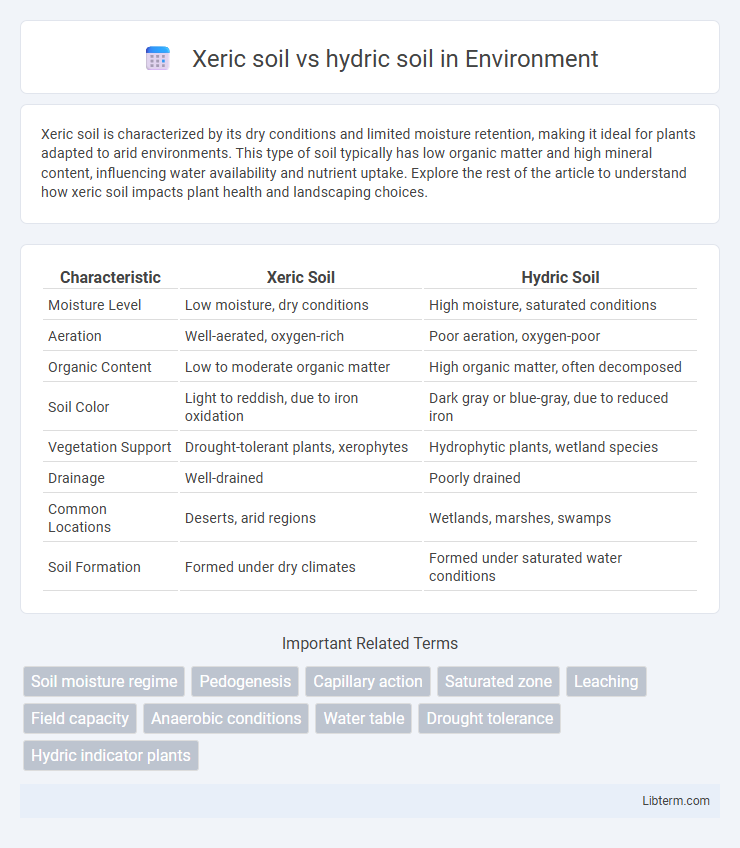Xeric soil is characterized by its dry conditions and limited moisture retention, making it ideal for plants adapted to arid environments. This type of soil typically has low organic matter and high mineral content, influencing water availability and nutrient uptake. Explore the rest of the article to understand how xeric soil impacts plant health and landscaping choices.
Table of Comparison
| Characteristic | Xeric Soil | Hydric Soil |
|---|---|---|
| Moisture Level | Low moisture, dry conditions | High moisture, saturated conditions |
| Aeration | Well-aerated, oxygen-rich | Poor aeration, oxygen-poor |
| Organic Content | Low to moderate organic matter | High organic matter, often decomposed |
| Soil Color | Light to reddish, due to iron oxidation | Dark gray or blue-gray, due to reduced iron |
| Vegetation Support | Drought-tolerant plants, xerophytes | Hydrophytic plants, wetland species |
| Drainage | Well-drained | Poorly drained |
| Common Locations | Deserts, arid regions | Wetlands, marshes, swamps |
| Soil Formation | Formed under dry climates | Formed under saturated water conditions |
Introduction to Xeric and Hydric Soils
Xeric soils are characterized by low moisture content and are typically found in arid and semi-arid environments, supporting drought-resistant vegetation adapted to dry conditions. Hydric soils develop in saturated, anaerobic environments such as wetlands, where prolonged water saturation influences soil chemistry and supports aquatic and moisture-tolerant plant species. Understanding the distinct properties of xeric and hydric soils is crucial for ecosystem management, agriculture, and environmental conservation.
Defining Xeric Soil: Key Characteristics
Xeric soil is characterized by low moisture content and high drainage capacity, typically found in arid and semi-arid regions where water retention is minimal. This soil type supports drought-resistant vegetation adapted to limited water availability and often exhibits sandy or rocky textures with sparse organic matter. In contrast with hydric soil, which remains saturated or flooded for prolonged periods, xeric soil promotes aerobic conditions essential for plants thriving in dry environments.
Hydric Soil: Properties and Identification
Hydric soil is characterized by saturation, flooding, or ponding long enough during the growing season to develop anaerobic conditions that influence soil properties and plant communities. These soils typically exhibit features such as gleying, organic matter accumulation, and redoximorphic concentrations, which are key indicators used in wetland delineation and environmental assessments. Identification of hydric soil involves field indicators like soil color patterns and texture, combined with laboratory analysis to confirm hydric conditions essential for supporting wetland ecosystems.
Differences in Soil Moisture Content
Xeric soil is characterized by low moisture content, commonly found in arid or semi-arid environments where water availability is limited and evaporation rates are high. Hydric soil maintains high moisture content, typical of wetlands, with saturated conditions that support anaerobic microorganisms and aquatic vegetation. The contrast in soil water retention directly influences plant species composition, soil aeration, and biochemical processes within these two distinct soil types.
Vegetation Adapted to Xeric Soils
Vegetation adapted to xeric soils includes drought-resistant plants such as cacti, succulents, and sagebrush, which have specialized structures like thick cuticles and deep root systems to conserve water. These plants thrive in well-drained, nutrient-poor environments characterized by low moisture availability and high evapotranspiration rates. Xeric soil vegetation exhibits physiological adaptations like CAM photosynthesis, enabling survival under prolonged water stress conditions.
Plant Life in Hydric Soil Environments
Plant life in hydric soil environments is adapted to saturated, oxygen-poor conditions that limit root respiration and nutrient uptake. Species such as cypress, mangroves, and various sedges develop specialized root systems like pneumatophores or aerenchyma tissues to facilitate oxygen transport. These adaptations enable survival and growth in wetlands, swamps, and marshes where hydric soils dominate.
Geographic Distribution and Examples
Xeric soils dominate arid and semi-arid regions such as the southwestern United States, parts of Australia, and North Africa, supporting drought-resistant vegetation like cacti and sagebrush. Hydric soils are prevalent in wetlands, including the Florida Everglades, Mississippi River Delta, and coastal marshes of the Gulf of Mexico, characterized by water saturation that favors hydrophytic plants like cattails and mangroves. These soil types distinctly influence local ecosystems due to their moisture availability and geographic occurrence.
Ecological Functions and Importance
Xeric soils, characterized by low moisture content, support drought-resistant vegetation and play a crucial role in preventing erosion and maintaining biodiversity in arid ecosystems. Hydric soils, saturated with water for prolonged periods, are essential for wetland ecosystems, promoting water filtration, nutrient cycling, and providing critical habitats for aquatic species. Both soil types sustain unique ecological functions vital for ecosystem stability and biodiversity conservation across contrasting environments.
Challenges in Soil Management
Xeric soils face challenges in water retention and nutrient availability due to their dry conditions and low organic matter, complicating irrigation and crop growth. Hydric soils, often saturated or waterlogged, present difficulties such as poor aeration, increased risk of root diseases, and nutrient leaching. Effective soil management must address these contrasting moisture dynamics by implementing tailored strategies like drainage for hydric soils and moisture conservation techniques for xeric soils.
Xeric vs. Hydric Soils: Summary Comparison
Xeric soils are characterized by dry conditions and low moisture retention, typically found in arid and semi-arid regions with sparse vegetation. Hydric soils, on the other hand, develop under saturated or flooded conditions, supporting wetlands and aquatic ecosystems. The primary distinction lies in moisture availability, which significantly influences soil chemistry, organic matter content, and plant species diversity.
Xeric soil Infographic

 libterm.com
libterm.com